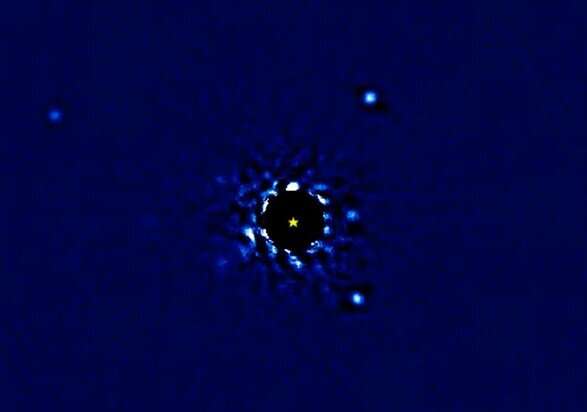A new time-lapse video depicts exoplanets circling their star for 12 years.
In 2008, HR8799 was the first extrasolar planetary system ever directly imaged. Now, the famed system stars in its very own video.
Using observations collected over the past 12 years, Northwestern University astrophysicist Jason Wang has assembled a stunning time lapse video of the family of four planets—each more massive than Jupiter—orbiting their star. The video gives viewers an unprecedented glimpse into planetary motion.

“It’s usually difficult to see planets in orbit,” Wang said. “For example, it isn’t apparent that Jupiter or Mars orbit our sun because we live in the same system and don’t have a top-down view. Astronomical events either happen too quickly or too slowly to capture in a movie. But this video shows planets moving on a human time scale. I hope it enables people to enjoy something wondrous.”
An expert in exoplanet imaging, Wang is an assistant professor of physics and astronomy in Northwestern’s Weinberg College of Arts and Sciences and a member of the Center for Interdisciplinary Exploration and Research in Astrophysics (CIERA).
HR8799 is a compact star located 133.3 light-years away from Earth in the Pegasus constellation. Although this seems unfathomably far away, HR8799 is considered within our “solar neighborhood.” Compared to our sun, HR8799 is 1.5 times more massive and roughly 5 times more luminous. It also is much younger. At around 30 million years young, the system formed after the dinosaurs went extinct.
In November 2008, HR8799 made history as the first system to have its planets directly imaged. Wang, who was instantly fascinated by the system, has been watching it ever since. He and his colleagues applied for time on the W. M. Keck Observatory, located on the top of Mauna Kea in Hawaii, to observe the system each year.
After seven years of observations, Wang put together imaging data to create his first time lapse video of the system. Now, armed with 12 years of imaging data, Wang released the updated video, which shows the entire time period in a condensed 4.5-second time lapse.
“There’s nothing to be gained scientifically from watching the orbiting systems in a time lapse video, but it helps others appreciate what we’re studying,” Wang said. “It can be difficult to explain the nuances of science with words. But showing science in action helps others understand its importance.”
To construct the video, Wang used technology called “adaptive optics” to correct image blurring caused by Earth’s atmosphere. He also used specialized instrumentation, called a “coronagraph,” and processing algorithms to suppress the glare from the system’s central star. (This is why the video has a black circle in the middle. Without this, the glare would be too intense to see the planets dancing around it.) Finally, Wang used a form of video processing to fill in data gaps and smooth out the planets’ motion. Otherwise, the planets would appear to jump around instead of smoothly orbit through space.
The final product shows four faint dots sailing around their central star. Although they look like mere fireflies, the planets are actually massive gas giants. Wang compares them to “scaled up versions” of Jupiter, Saturn, Neptune and Uranus. The planet nearest the star takes about 45 Earth years to make one revolution. The farthest planet, on the other hand, takes nearly 500 years to trace the same path.
For Wang, exploring space through videos is the best part of his job. Next, Wang and his collaborators are examining the light emitted from the star and its planets in order to better understand what they are made of.
“In astrophysics, most of the time we are doing data analysis or testing hypotheses,” he said. “But this is the fun part of science. It inspires awe.”
Source:PhysORG
Do not forget to share your opinion with us to provide you with the best posts !



0 Comments